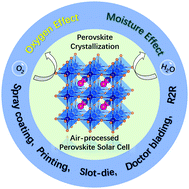Progress in air-processed perovskite solar cells: from crystallization to photovoltaic performance†
Abstract
Marked progress has been made in organometallic halide perovskite (OHP) solar cells, with their power conversion efficiency reaching up to 24.2% owing to the excellent optoelectronic properties such as high light absorption coefficients, long carrier diffusion lengths, and high carrier mobilities. Among the reported highly efficient devices, most were fabricated in a well-controlled inert environment. However, large-scale manufacturing requires ambient processing, which affects the crystallization process of OHP. Recently, considerable attention has been drawn to developing air-processed OHP solar cells, in terms of scientific understanding of the crystallization process and developing processes compatible with large volume manufacturing. This review article summarizes the recent progress made in air-processed OHP solar cells. Specifically, we focus on (1) the microscopic understanding of the impact of the ambient environment on the crystallization process of OHP composites, (2) the approaches to control the crystallization and morphology of OHP in ambient air, and (3) the fabrication processes to achieve highly efficient air-processed OHP solar cells. Finally, we will discuss the challenges and pathways toward commercialization of low-cost air-processed OHP solar cells.



 Please wait while we load your content...
Please wait while we load your content...